
You’re looking for a travel guitar which means you’re looking for something portable and durable. But you’re also a guitarist, which means you still want an instrument that plays comfortably and sounds great. Luckily, these days there are plenty of smaller guitars that fit the bill.
So don’t get suckered into buying something that’s little more than a cheap, child-sized guitar. Let us help you find the perfect instrument.
What To Know Before Buying an Acoustic Travel Guitar?
When choosing a guitar for travel, the size, weight, and durability will be of greater importance, but you still want an instrument that sounds great and excels at your favorite style of music. This buyer’s guide is here to help you find that perfect balance.
Size and weight are important
When buying any guitar, the size and weight are principal considerations, because you need an instrument that feels comfortable in your arms, but they become far more important when shopping for a travel guitar.
To determine the size of travel guitar you need, think about the type of trips you usually take. If you travel primarily by plane, look for something that can fit in an overhead bin. These bins can vary considerably in size, so your best bet is to call your air carrier, though as a guideline, standard carry-on dimensions are around 22” x 16” x 10”.
If you’re interested in backpacking, busking, or camping with your guitar and will be carrying it mostly on foot, the overall length may not be as important. Instead, aim for something lightweight or even small enough to slot into a backpack.
Look for something durable
For a guitar intended to travel, durability can be as important as size, particularly if you expect longevity from your instrument. Many small guitars are designed for children or beginners, rather than travel, and may not feature the quality of construction required. Prepare to pay a little more upfront for a guitar that you can put through its paces.
These days, manufacturers are getting more inventive when it comes to guitar material, venturing beyond the classic tonewoods. If you want true durability, consider a carbon fiber or other composite-material guitar. They have their own unique sound, are far more durable than wooden guitars, and are less susceptible to warping when encountering temperature or humidity changes during travel .
| Carbon Fiber | Wood | |
| Volume | Louder | Quieter |
| Resistance to dents, scratches, and cracks | More resistant | Less resistant |
| Resistance to warping | More resistant | Less resistant |
| Weight | Lighter | Heavier |
| Aging | Sound won’t change with age | Sound can improve with age |
| Manufacturing | More difficult | Easier |
| Price | More expensive | Less expensive |
Many travel guitars come with a hard or soft case, and if they don’t, this should be considered a mandatory purchase to protect your guitar. Which style of case you buy should be based on your travel needs. Hard cases offer better protection for your instrument, when flying or traveling by bus, but they will be heavy when traveling on foot.
Don’t Ignore Tonewood When Choosing
A guitar’s tonewoods have a significant effect on the sound of your guitar, particularly the top wood, also known as the soundboard . When it comes to choosing a travel guitar, don’t get so caught up looking for a compact instrument that you forget to seek out great sound. If you don’t like to play it, it will only collect dust and add to your travel weight.
Most luthiers, but not all, believe that the wood chosen for the top is the single overriding variable that determines the quality of tone of a finished instrument.
Two of the most common tonewoods you’ll encounter are spruce and mahogany. Both are equally suitable for a travel guitar, so choose the one with the sound you prefer. Spruce is a light wood with a bright sound, while mahogany is a denser wood with a warmer sound.
When choosing a travel guitar, pay close attention to whether the tonewoods are solid wood or laminates. Many manufacturers use laminated wood for their smaller instruments, because it helps them keep the prices of these guitars low, but solid wood offers better sound quality. However, laminated wood is less prone to warping when undergoing changes in temperature and humidity, which may be advantageous if your travel takes you to different climates.
Will you be practicing, or performing?
Some travel guitars are simply scaled-down models of full sized guitars. They’re manufactured from high-end tonewoods and produce a quality sound, though not with the same volume or depth as their full-size counterparts.
These are great options for strumming around the campfire or jamming with friends.
In contrast, for an ultra-compact guitar, an acoustic-electric travel guitar is a better option, because it doesn’t rely on a large body to project sound. If you just need a guitar for practice, these can be a great choice, because they are virtually soundless when played without an amplifier or can be played with a pair of headphones plugged into the jack. They can be used for performing as well, provided you have an amp.
What are the Best Acoustic Travel Guitars?
A travel acoustic guitar can come in any style, from a scaled-down classic dreadnought to ultra-light acoustic-electric that is barely more than a fretboard. No matter what you like to play or how you like to travel, there’s sure to be one to meet your needs.
1. Taylor BT2 Baby Taylor – Best Overall

Specifications
- Dimensions: 15.75” L x 12.5” W x 3.38” D
- Weight: 4.41 pounds
- Top wood: Tropical mahogany
- Back and side wood: Laminated sapele
- Type: ¾-size dreadnought
Taylor is one of the best manufacturers of acoustic guitars, known worldwide for their high-quality design and craftsmanship. Recently, they have gained particular recognition for their small guitars, which are able to deliver a surprisingly big sound by featuring the same engineering and materials as the full-size models.
The Taylor BT2 Baby Taylor, a ¾-size dreadnought guitar, is our pick for the best travel acoustic guitar this year, thanks to its premium construction, unique sound, and practical size .
The Baby Taylors sport a 22.25-inch scale length, and a 15.75-inch long body – making them the perfect travel companion to your main guitar, or just a great versatile addition to your collection.
The top is tropical mahogany, which produces a darker, earthier tone — what Taylor describes as a bluesy edge — than a spruce top option like the Martin LX1. This allows for strong and clear fundamentals. The back and sides are laminated sapele, which keeps the price point affordable without sacrificing much in the way of sound. A durable varnish finish means it will hold up to the bumps and scrapes of regular travel.
It has a soft tone profile, which can almost sound like you’re playing nylon strings. This makes it particularly adept at rhythm playing, but you can achieve a brighter sound by picking with your fingernails or using a heavier pick. It’s also remarkably versatile when it comes to playing in alternate tunings.
2. Martin LX1 Little Martin – For Performing

Specifications
- Dimensions: 15” L x 12” W x 3” D
- Weight: 3.41 pounds
- Top wood: Solid Sitka spruce
- Back and side wood: Mahogany-patterned HPL
- Type: ¾-size dreadnought
Along with Taylor, Martin is one of the most respected manufacturers of acoustic guitars, with a history stemming back to 1833.
LIke the Baby Taylor, the LX1 Little Martin is a scaled-down version of a full-size dreadnought acoustic guitar. It’s the smallest guitar Martin manufactures, but its design and construction is in keeping with the company’s reputation for quality.
The top is solid Sitka spruce, which gives a clear sound, while the sides are laminated mahogany. Inside, you’ll find the same high-end X-bracing seen on their top-of-the-line instruments. The result is a beautiful balance between warm and bright tones, with the expected crisp high notes but a still audible bottom end. Indeed, the LX1 offers a much deeper and fuller sound than you would expect from a small guitar.
While it was conceived as a guitar for children or travelling, the unique and rich sound of the LX1 has led to its adoption by experts and touring professionals as well .
3. Luna Safari Series Muse Mahogany – Budget Pick
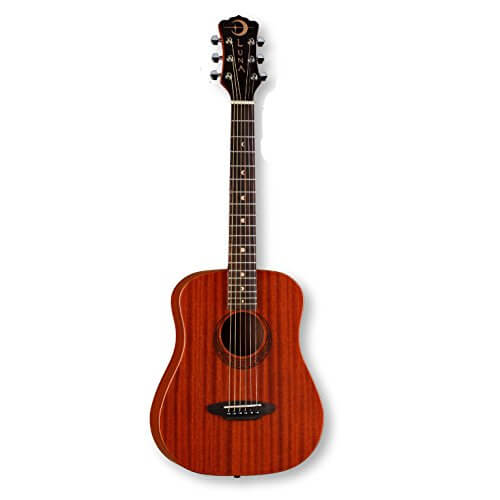
Specifications
- Dimensions: n/a
- Weight: 2.60 pounds
- Top wood: Mahogany
- Back and side wood: Mahogany
- Type: ¾-size dreadnought
The Luna Safari Series Muse is a surprisingly low-priced guitar, given its premium materials and quality construction. This is a budget instrument without a budget sound.
This ¾-size dreadnought features a mahogany body and top that gives it a surprisingly rich voice despite its small size, with deep warm tones that are particularly well-suited to fingerpicking. A Celtic laser etching around the soundhole is the sort of touch that makes this instrument look more expensive than it is. The mahogany neck is a comfortable C shape, with a satin finish that makes playing fast and smooth.
For travelers, a soft gig bag is included, so you and your guitar will be ready to hit the road.
4. Traveler Guitar Escape Mark III – Best Acoustic-Electric Guitar
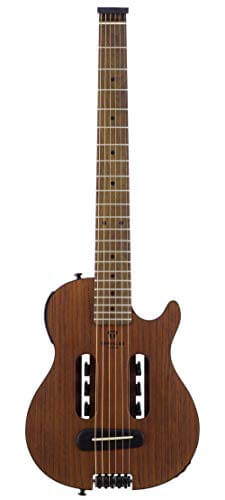
Specifications
- Dimensions: 30” total L x 10.75” W x 2.13” D
- Weight: 3.75 pounds
- Top wood: Alder
- Back and side wood: Alder
- Type: Acoustic-electric
When a company specializes in one thing, they tend to do that thing very well. And Traveler Guitar, an independent company based in California that focuses on producing the best travel guitars, is no exception. In fact, we’ve included two of their guitars on our list!
Traveler has made it a priority to craft guitars with a small overall length while still maintaining a full-size scale, a feat they achieve using their proprietary in-body tuning system, which eliminates the need for a headstock.
As a result, the Escape Mark III acoustic-electric guitar has a 25.5” scale while measuring just 30” total, small enough to fit in an airplane overhead bin. Though players with big fingers have found it slightly more difficult to access the tuning keys.
The body is made of alder, which offers good resonance and sustain with low weight, and the bolt-on maple neck is quick and responsive. A Shadow NanoFlex under-saddle pick-up and preamp system make it performance ready, while a headphone output allows you to practice anywhere, and an included gig bag makes travel easy.
5. Martin Steel String Backpacker – Best for Backpacking
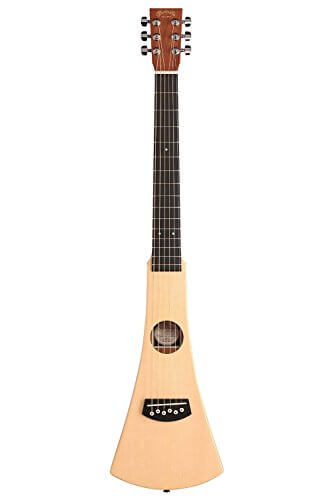
Specifications
- Dimensions: 33” total L x 7.25” W x 1.93” D
- Weight: 2.13 pounds
- Top wood: Solid spruce
- Back and side wood: Mahogany
- Type: Parlor acoustic
This guitar’s name says it all. The Martin Backpacker is a perfect acoustic guitar for backpacking. Yes, its tiny size and unusual oar shape mean that it won’t sound the same as a traditional dreadnought. But it’s still a Martin guitar, so its quality construction and premium tonewoods promise a unique and enjoyable playing experience.
Weighing in at just 2.13 pounds, the lightest on this list, the Backpacker features a solid spruce top and solid mahogany sides and back that give it a rich and balanced tone with surprising volume for such a small instrument. And what it lacks in volume, it makes up for with a great, clear tone and nice sustain.
Its construction is durable, designed for the perils of camping, hiking, and summer music festivals, and it comes with both a strap and gig bag.
6. Traveler Guitar Ultra Light Acoustic – Most Compact
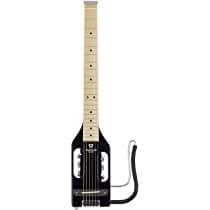
Specifications
- Dimensions: 28” total L x 5.25” W x 2” D
- Weight: 2.88 pounds
- Top wood: Maple
- Back and side wood: Maple
- Type: Ultra-light acoustic-electric
The second Traveler guitar on our list is perhaps the most unique inclusion, with a body less than 6 inches wide. This ultra-light acoustic-electric guitar with a highly compact design manages to both sound and play like a full-sized guitar, despite measuring only 28” long and weighing less than three pounds. This is facilitated by the in-body tuning system, which makes this guitar 31% shorter and 43% lighter than a full-sized acoustic guitar.
It features a one-piece Eastern American hard maple neck-through-body design, for excellent sustain, and a full-size 24.75” scale. When plugged in, the piezo pickup provides an impressively crisp and articulate tone, though the guitar itself lacks volume control. When unplugged, this guitar is near silent, perfect for practice no matter where you are.
It also includes a detachable lap frame, which allows it to sit comfortably on your lap while you play without adding size or weight. When in travel, the frame slots easily into the included heavy-duty gig bag.
7. Cordoba Mini M – Best Classical
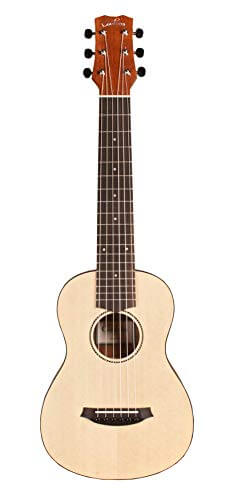
Specifications
- Dimensions: 10.04” L x 7.68” W x 2.95” D
- Weight: 2.5 pounds
- Top wood: Solid spruce
- Back and side wood: Mahogany
- Type: ¾-size parlor classical
Cordoba is a popular manufacturer of classical guitars, and the Mini M is cited by many classical guitarists as their favorite option for travel. In developing this compact guitar, Cordoba opted to maintain the full nut width of 1.96”, which means the Mini M still has the feel of a full-sized guitar, despite its short 20” scale length.
It has a solid spruce top coupled with mahogany back and side, a popular combination that yields a rich and full sound, with both depth and brilliance. The solid mahogany neck provides maximum transfer of vibration, yielding incredible tone and sustain that capture every nuance of your playing.
Extra touches, like a bone nut and saddle, Indian rosewood binding, and silver tuners with black buttons, give the Mini M a premium look that belies its affordable price tag, and a gig bag is included as a bonus for travelers.
8. KLOS Carbon Fiber Travel Guitar – Most Durable
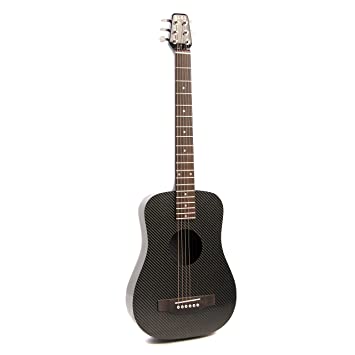
Specifications
- Dimensions: 15” L x 11.5” W x 3.5” D
- Weight: 2.86 pounds
- Top wood: Carbon fiber
- Back and side wood: Carbon fiber
- Type: ¾-size dreadnought
KLOS is the brainchild of two brothers, one of whom was a guitarist with expertise in composite materials. Frustrated by the way wooden acoustics warp when exposed to temperature and humidity changes, he designed and built a guitar from carbon fiber to eliminate the problem.
The KLOS Travel model is a ¾-size dreadnought with a proprietary bolt-on neck that can be removed to make the guitar even more compact. Carbon fiber stiffening rods in the neck itself are used to minimize the effects of temperature and humidity changes.
The body is entirely carbon fiber, which is far more durable than wood, either when exposed to climatic extremes or when scraped and bumped during travel. Just check out the video of their carbon fiber ukulele being run over by a car !
KLOS doesn’t claim carbon fiber offers a better or worse sound than natural wood, just a different one. However, due to the strength of the carbon composite, the guitar requires less internal bracing, which allows it to resonate more freely, and as a result, it achieves surprising volume for a ¾-size instrument.
The Verdict
Even if it isn’t your primary guitar, there’s no reason to sacrifice sound quality when it comes to choosing an instrument for travel, whether by airplane or on foot. This article offers 8 options for highly portable guitars that are light, compact, durable, and most importantly, sound great.
Our top pick is Taylor’s BT2 Baby Taylor, a ¾-size dreadnought with a mahogany body. Its rich, full tones and quality craftsmanship are sure to please, and like all the best acoustic guitars, it will only improve with time.
FAQs
Are travel guitars easier to play?
Yes, if your travel guitar is smaller than your regular guitar, it may feel easier to play. The small size and light weight can be easier to manage physically, and the shorter scale results in less string tension.
What is the difference between a travel guitar and a regular guitar?
Unofficially, a travel guitar is any guitar that is practical to travel with. This typically refers to its small size, light weight, and durability. Some manufacturers differentiate between ¾-size guitars and travel guitars based on scale length.
Can a guitar go on a plane?
Yes, if you can fit your guitar into an overhead luggage bin, it is written into law that you can carry it on the plane. If it doesn’t fit into the overhead bin, however, you will either have to check it or buy it its own ticket .
